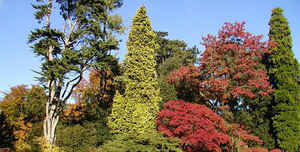US National Tree
Oak
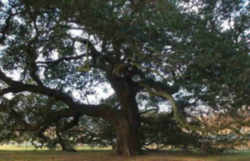
(Fagaceae Quercus)
Adopted in 2004.
Nearly Five years after being voted the United States' favorite tree, recent Congressional passage and presidential signing of an historic bill makes it official - America's National Tree is the Oak. The actual voting took 4 months to cast and tally. The tree was selected from 21 candidate trees, based on broad tree categories (genera) that included the State Trees of all 50 states and the District of Columbia.
US National Tree: Oak
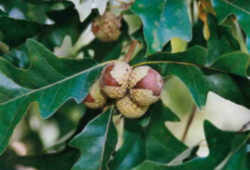
The term oak can be used as part of the common name of any of about 400 species of trees and shrubs in the genus Quercus (from Latin "oak tree"), which are listed in the List of Quercus species, and some related genera, notably Lithocarpus. The genus is native to the northern hemisphere, and includes deciduous and evergreen species extending from cold latitudes to tropical Asia and the Americas.
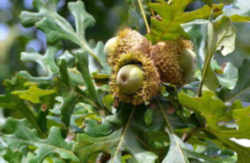
There are 90 species of oak native to the United States, in addition to many hybrids and a few introduced species. Native oak species occur in every state except Alaska, Hawaii, and Idaho.
Oaks have spirally arranged leaves, with a lobed margin in many species; some have serrated leaves or entire leaves with a smooth margin. The flowers are catkins, produced in spring. The fruit is a nut called an acorn, borne in a cup-like structure known as a cupule; each acorn contains one seed (rarely two or three) and takes 6--18 months to mature, depending on species.
OAK BECOMES AMERICA'S NATIONAL TREE
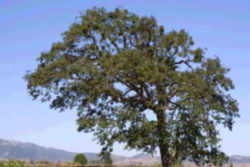
12/10/04
For more information, contact
Arbor Day Foundation
Sean Barry
sbarry@arborday.org
Nebraska City, Neb., Dec. 15, 2004--America has the grandest trees on earth--the largest, the oldest, and some of the most magnificent. Now, with Congressional
passage and presidential signing of a historic bill, America has an official National Tree--the oak.
Congress passed legislation so designating the oak in November. The official recognition of oak as America's National Tree reflects a vote hosted by
The National Arbor Day Foundation at its website, arborday.org, in which Americans of all ages and from all walks of life helped choose the country's
newest national symbol.
"Having oak as our National Tree is in keeping with the wishes of the hundreds of thousands of people who helped choose this striking symbol of our
nation's great strength," said John Rosenow, president of The National Arbor Day Foundation. "The United States is blessed with a wealth
of tree species--more than twice as many as all of Europe--and trees have played a key role in our nation's history. Naming a national tree is a cause
for celebration for us all. We're grateful to the leadership of Congressman Bob Goodlatte of Virginia and Senator Ben Nelson of Nebraska for helping
this become a reality."
"As Chairman of the House Agriculture Committee, I appreciate how trees and forests enhance the environment, add recreational opportunities, and
provide for the livelihoods of millions of individuals in the forest industry," said Congressman Goodlatte. "The oak has long been an enduring
and mighty tree. It is truly a part of our national heritage and merits the formal distinction of America's National Tree."
"The oak tree will now be as much a symbol of America as Thanksgiving Day, Old Glory, the Star Spangled Banner, and the bald eagle," Senator
Nelson said. "It is a fine choice to represent our nation's strength, as it grows from just an acorn into a powerful entity whose many branches
continue to strengthen and reach skyward with every passing year."
The oak was selected during a four-month-long open voting process hosted by the Arbor Day Foundation. From the first day of voting, oak was the people's
clear choice, finishing with more than 101,000 votes, compared to almost 81,000 for the magnificent runner-up, the redwood. Rounding out the top five
were the dogwood, maple, and pine.
As part of the process, people were invited to vote for one of 21 candidate trees, based on broad tree categories (genera) that included the state
trees of all 50 states and the District of Columbia, or to write in any other tree selection. "We undertook this vote to remind Americans of just
how important trees are to us all, and to emphasize the history and grandeur of our trees," Rosenow said.
Advocates of the oak praised its diversity, with more than 60 species growing in the United States, making oaks America's most widespread hardwoods.
Throughout America's history, oaks have been prized for their shade, beauty, and lumber. They have also been a part of many important events, from
Abraham Lincoln's use of the Salt River Ford Oak as a marker in crossing a river near Homer, Illinois, to Andrew Jackson taking shelter under Louisiana's
Sunnybrook Oaks on his way to the Battle of New Orleans. In the annals of military history, "Old Ironsides," the USS Constitution, took its
nickname from the strength of its live oak hull, famous for repelling British cannonballs.
More information about America's National Tree and all of the other candidate trees is available at arborday.org, the official website of The National
Arbor Day Foundation. The Arbor Day Foundation is a nonprofit educational organization that inspires people to plant, nurture, and celebrate trees.
US Senate Bill 811
S 811 IS
107th CONGRESS
1st Session
S. 811
To amend title 36, United States Code to designate the oak tree as the national tree of the United States.
IN THE SENATE OF THE UNITED STATES
May 1, 2001
Mr. NELSON of Nebraska (for himself and Mr. CRAPO) introduced the following bill; which was read twice and referred to the Committee on the Judiciary
A BILL
To amend title 36, United States Code to designate the oak tree as the national tree of the United States.
Be it enacted by the Senate and House of Representatives of the United States of America in Congress assembled,
SECTION 1. DESIGNATION OF NATIONAL TREE.
(a) DESIGNATION- Chapter 3 of title 36, United States Code, is amended by adding at the end the following:
`Sec. 305. National tree
`The tree genus Quercus, commonly known as the oak tree, is the national tree.'.
(b) CONFORMING AMENDMENTS- Title 36 is amended--
(1) in the table of contents for part A of subtitle I, by striking `, and March' and inserting `March, and Tree';
(2) in the chapter head for chapter 3, by striking `, AND MARCH' and inserting `MARCH, AND TREE'; and
(3) in the table of sections for chapter 3, by adding at the end the following:
`305. National tree.'.
US House Bill 1936
HR 1936 IH
107th CONGRESS
1st Session
H. R. 1936
To amend title 36, United States Code, to designate the oak tree as the national tree of the United States.
IN THE HOUSE OF REPRESENTATIVES
May 22, 2001
Mr. GOODLATTE (for himself, Mr. GOSS, and Mr. OSBORNE) introduced the following bill; which was referred to the Committee on the Judiciary
A BILL
To amend title 36, United States Code, to designate the oak tree as the national tree of the United States.
Be it enacted by the Senate and House of Representatives of the United States of America in Congress assembled,
SECTION 1. DESIGNATION OF NATIONAL TREE.
(a) DESIGNATION- Chapter 3 of title 36, United States Code, is amended by adding at the end the following:
`Sec. 305. National tree
`The tree genus Quercus, commonly known as the oak tree, is the national tree.'.
(b) CONFORMING AMENDMENTS- Title 36 is amended--
(1) in the table of contents for part A of subtitle I, by striking `, and March' and inserting `March, and Tree';
(2) in the chapter head for chapter 3, by striking `, AND MARCH' and inserting `MARCH, AND TREE'; and
(3) in the table of sections for chapter 3, by adding at the end the following:
`305. National tree.'.
Taxonomic Hierarchy: White Oak
Kingdom: Plantae - Plants
Subkingdom: Tracheobionta - Vascular plants
Superdivision: Spermatophyta - Seed plants
Division: Magnoliophyta - Flowering plants
Class: Magnoliopsida - Dicotyledons
Subclass: Hamamelididae
Order: Fagales
Family: Fagaceae - Beech family
Genus: Quercus L. - oak






